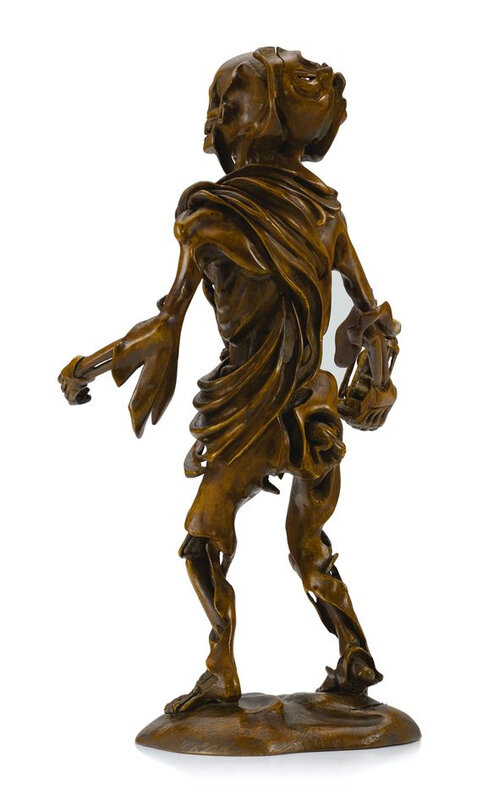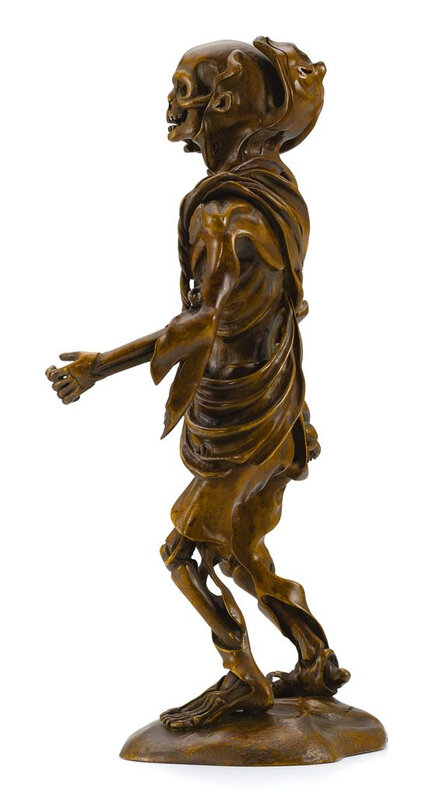A carved boxwood memento mori skeleton, Southern Germany, 17th century
Lot 3050. A carved boxwood memento mori skeleton, Southern Germany, 17th century; 26.2 cm, 10 1/4 in. Estimate 400,000 — 600,000 HKD. © Sotheby's 2018.
well carved as Todlein standing on a irregular stand with its head turning to the left, the right hand portrayed holding an hourglass supporting a frog, the figure of Death powerfully depicted with a layer of skin around the skull and remnants of skin acting as clothing and partially revealing the skeletal structure, further adorned with a sash strung across the torso, the surface richly patinated to a smooth honey-brown colour.
Note: This extraordinary figure of Death relates closely to an example in the Badisches Landesmuseum, Karlsruhe, as well as one in the Bayerisches Nationalmuseum, which is dated 1673 (see H. Beck and B. Decker, eds, Dürers Verwandlung in der Skulptur zwischen Renaissance und Barock, exh. cat. Liebieghaus, Frankfurt am Main, 1981, nos 191 and 191a); note the skin around the head and the sash across the torso exhibited by all three. The attribute of an hourglass is seen in a bronze skeleton from Augsburg now in Strasbourg, illustrated ibid., no. 190, as well as in an example dated to the 16th century by Bange (see E. F. Bange, Die Kleinplastik der Deutschen Renaissance in Holz und Stein, Florence and Munich, 1928, pl. 72). Here the innovative detail of a frog perching atop the hourglass, a popular memento mori symbol, adds further interest to the composition.
Representations of memento mori motifs – reminders of the fleetingness of life – gained currency in the Renaissance, particularly in Reformation-led Germany. Acting as moral guardians with connotations of sin, decay and the afterlife, such objects were valued equally as curiosities, satisfying the Renaissance obsession with human anatomy and the grotesque. The early 16th century saw the rise of skeletons personifying death – so-called Tödleine ('little deaths') – as an independent genre in Southern German small-scale sculpture. Perhaps the earliest of these is a figure by the Bavarian sculptor Hans Leinberger of circa 1520 (Beck, op. cit., fig. 63), which defines the type as a skeletal body in an advanced state of decomposition, with remnants of skin acting as stand-in clothing, and equipped with death-bringing attributes such as a bow and arrow or an hour glass. Further 16th-century examples following this scheme are illustrated in Bange (op. cit., pls. 72-73). In the 17th century the popularity of the type was renewed by sculptors within the Dürer Revival movement.
Only a small number of Tödleine comparable to the present example has appeared on the market in recent years; one sold at Christie's Paris as part of the Yves Saint Laurent and Pierre Bergé collection on 23th-25th February 2009, lot 481, while two others were sold in our London rooms, 6th July 2017, lots 106 and 109. See also a sixteenth-century German wood memento mori skull offered in this sale, lot 3008.
Sotheby's. Curiosity IV, Hong Kong, 02 Apr 2018, 10:30 AM

/https%3A%2F%2Fprofilepics.canalblog.com%2Fprofilepics%2F1%2F0%2F100183.jpg)
/https%3A%2F%2Fstorage.canalblog.com%2F03%2F02%2F119589%2F96711876_o.jpg)
/https%3A%2F%2Fstorage.canalblog.com%2F11%2F31%2F119589%2F94773502_o.jpg)
/https%3A%2F%2Fstorage.canalblog.com%2F20%2F83%2F119589%2F94772815_o.jpg)
/https%3A%2F%2Fstorage.canalblog.com%2F26%2F72%2F119589%2F75604929_o.jpg)
/https%3A%2F%2Fstorage.canalblog.com%2F59%2F60%2F119589%2F26458628_o.jpg)





/http%3A%2F%2Fstorage.canalblog.com%2F32%2F99%2F119589%2F129836631_o.jpg)
/http%3A%2F%2Fstorage.canalblog.com%2F46%2F82%2F119589%2F129704536_o.jpg)
/http%3A%2F%2Fstorage.canalblog.com%2F49%2F48%2F119589%2F129680938_o.jpg)
/http%3A%2F%2Fstorage.canalblog.com%2F64%2F83%2F119589%2F129635530_o.jpg)